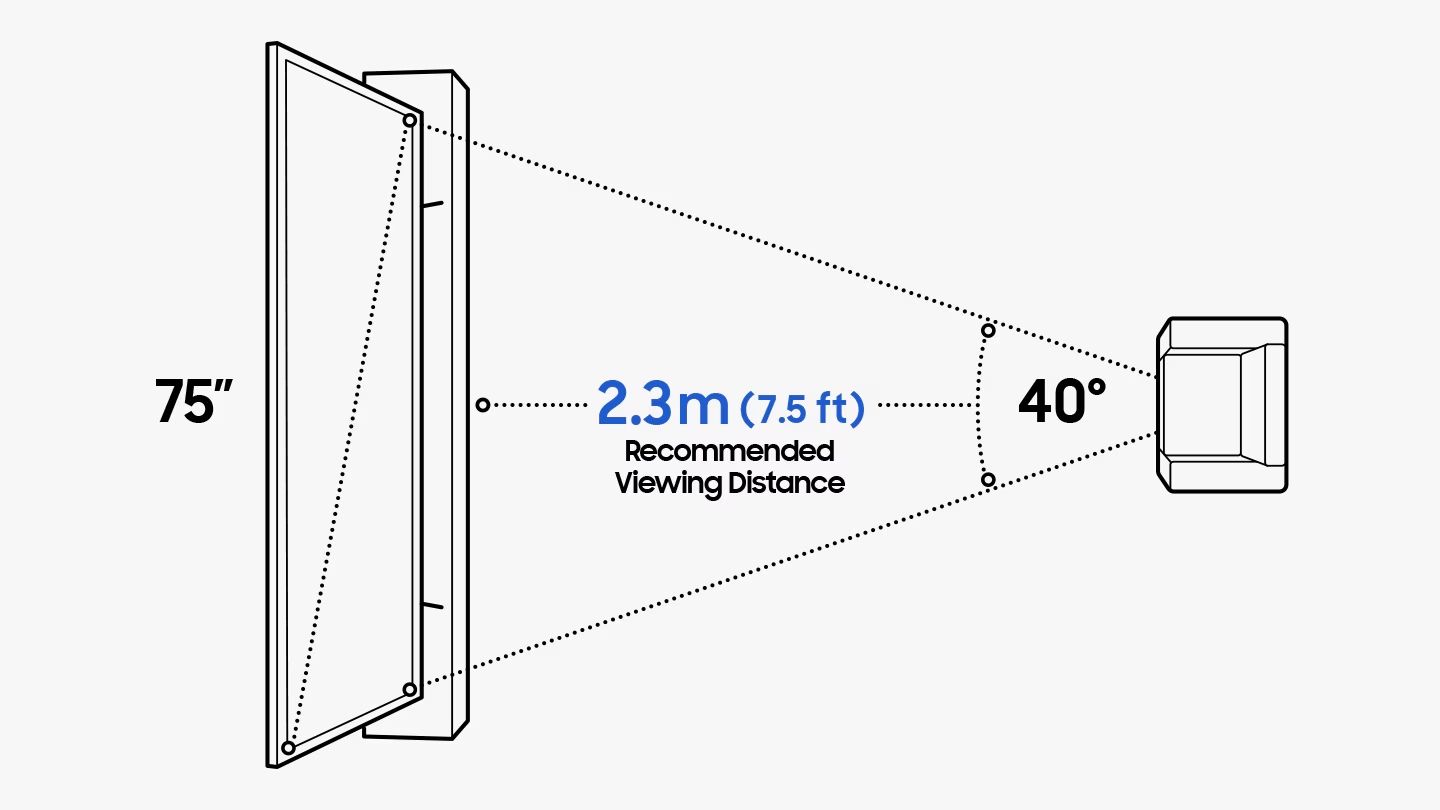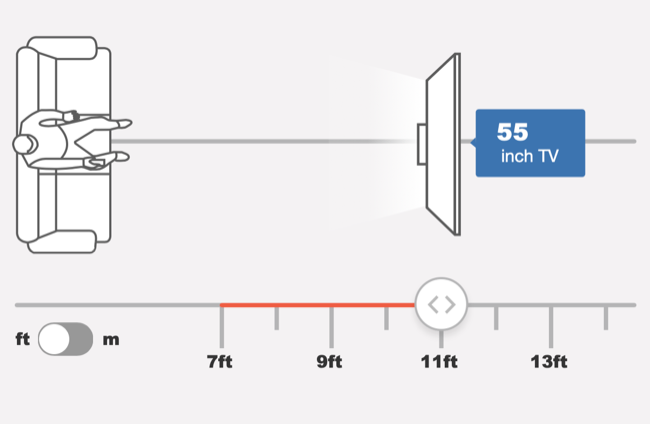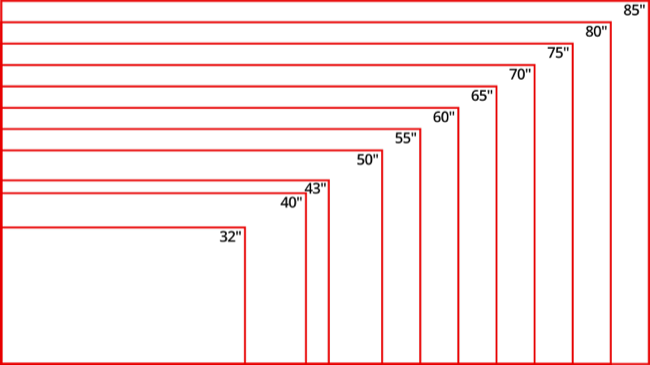
TV Sizing Guide: Finding Your Optimal Display Dimensions for Ultimate Viewing Comfort

TV Sizing Guide: Finding Your Optimal Display Dimensions for Ultimate Viewing Comfort
Quick Links
- What Size TV Should I Get? Know the Field of View
- Calculating Screen Size by Viewing Distance
- Calculating Viewing Distance by Screen Size
- Using Online Calculators Makes It Easy
- Personal Preference Can Make a Big Difference
- Visualizing How Your TV Will Look
- Buying Bigger? Expect an Adjustment Period
- Consider a Money-Back Guarantee
When shopping for a new TV, you might be tempted to buy the biggest model you can afford. That sounds great, but you’ll be surprised how uncomfortable it can be to sit in front of a TV that’s too big for your space. We’ll help you figure out the ideal TV size for your room and go from there.
What Size TV Should I Get? Know the Field of View

Samsung
The metric you need to know for dialing in on the best TV size for any space is “field of view.” This is essentially a measurement of how wide you can see from left to right when looking straight ahead. In the case of TVs, we’re talking about how much of that field of view should be taken up by the screen.
The Society of Motion Picture and Television Engineers (SMPTE) states that a field of vision of between 30 to 40 degrees provides an optimal viewing experience for most content. That means the TV takes up 40 degrees of your field of view. The SMPTE describes itself as “a global professional society of individuals and corporations collaborating for the advancement of all things technical in the motion picture, television, and digital media.”
In cinemas, THX recommends a field of view of 36 degrees for cinematic presentations. THX was established in part by George Lucas in 1983 to develop high-fidelity standards for visual mediums, including television and cinema. That lines up with the SMPTE recommendation, too.
Calculating Screen Size by Viewing Distance
The field of view you experience depends on how far you are sitting from the television. If you know how far you’re going to be sitting, you can use this distance to calculate an “ideal” screen size in inches. For a 30-degree viewing angle, multiply the viewing distance by 0.6, or to get closer to a 40-degree viewing angle, multiply your viewing distance (in inches) by 0.84.
For example, if you are sitting 60 inches from the TV (around 5 feet or 1.5 meters), a screen range of between 36 and 50 inches is recommended.
Calculating Viewing Distance by Screen Size
If you’re happy to adjust your viewing distance based on screen size (or are trying to work out if you have enough room to do so), you can use a similar calculation to work out how far away from a display you should sit. For a 30-degree viewing angle, multiply the diagonal screen size by 1.6, or for a 40-degree angle, multiply by 1.2.
For example, a 65-inch TV would have a 30-degree field of view at 104 inches (around 8.7 feet or 2.6 meters) and a 40-degree field of view at 78 inches (around 6.5 feet or 2 meters).
Using Online Calculators Makes It Easy
If math isn’t your strong point, there are a range of online calculators you can use, though there can be some variation in the results since some adhere strictly to 30-degrees while others go a little higher. These include the RTINGS TV Size to Distance Calculator , the Which TV Size Tool , and the Inch Calculator .

Personal Preference Can Make a Big Difference
You may have your own idea of what your preferred angle of view or viewing distance is. Some people like to sit very close to the TV, especially when playing games or watching movies. Be aware that your ability to resolve the image declines when you exceed a 40-degree viewing angle.
You can use the calculations above to figure out what you’re already used to. For example, if you’re upgrading from a 40-inch or 50-inch screen, working out what field of view you are comfortable with can help you pick a larger display that would provide a similar viewing experience.

RTINGS.com
On a larger display, it’s common to find yourself moving your eyes to capture the whole frame, and this is fairly normal. If you find that you have to move your head (not just your eyes), then this is a good sign that you are either sitting way too close or have a screen size that’s too big for your space.
At the end of the day, how you feel most comfortable while relaxing is an entirely personal choice.
Visualizing How Your TV Will Look
One of the best ways of visualizing how a larger TV will look in your living room is to create a cardboard model of the screen size. You can do this by taping a few old boxes together, then prop it up in place and stand back.
This won’t simulate what it’s like watching content on the TV, but it will give you a good idea of whether the field of view is too wide, or whether the TV looks ridiculous in a small room. You can move furniture around to suit or see what difference mounting the TV on the wall would make.
This technique is useful from a home design perspective, but it’s not an exact science. You should be able to see whether the edges of the screen are too wide for comfortable viewing, but you won’t know for sure until you get the TV up in person.
Buying Bigger? Expect an Adjustment Period
One thing is for sure: even if you are within the 30 to 40 degrees recommended field of view, a new TV can take some time to get used to. From our experience, it can take anything from a few weeks to a few months to get used to the size of a large display.
In that time you might adjust the height or distance you sit from your display to feel more comfortable. It isn’t unusual to experience cybersickness with larger displays, especially while playing games. This is like motion sickness but in reverse, where you see movement on the screen but don’t feel it in your muscles or inner ear.
Provided your TV is hovering around the 30 to 40 degree field of view mark, you will eventually get used to it and stop noticing the increased size. Turning the brightness down can help you adjust since many models use overly vibrant picture modes out of the box. If you’re not used to the at-times searing peak brightness of new HDR sets, that can make the size stand out even more.
Consider a Money-Back Guarantee
For ultimate peace of mind when purchasing a TV, consider buying from a retailer that offers a money-back guarantee if you’re not happy. Local independent retailers often honor these policies, as do big retailers like Best Buy provided you’re within the return period.
Keep in mind that large TVs that are 65 inches or larger can be difficult to transport, so you’ll have to figure out how to get the TV back to the retailer if you do end up changing your mind. Always pay attention to the arrows on a TV box that informs how the unit should be stored and transported.
Transporting some TVs, particularly OLEDs with their thin panels, can cause the panel to bend or break if these instructions are not followed correctly.
Follow Our TV Buying Guide for More Advice
Buying a TV can be a big decision and one you aren’t going to want to make too often. A good TV should last you the best part of a decade before evolving standards or failing electronics forces you to buy another.
To get this decision right, we’ve produced a TV buying guide and a list of the best TVs on the market . If gaming is your primary concern, check out our guide to TVs for gamers , too.
Also read:
- [New] Efficient Snap Catch Strategies for 2024
- [New] Ignite Your Brand's Potential Immerse in Our Exclusive Collection of over 50 Free YouTube Banners for 2024
- [Updated] Free Online Platform Convert Any FB Video Into a Song for 2024
- 2024 Approved Real-World Applications of Magix Video Pro X
- A Quick Guide to Xiaomi Redmi 13C 5G FRP Bypass Instantly
- Best 5 Mac-Based Music Editing Tools: Streamline Your Production Workflow
- Best Free Video-to-Audio Software: Top 3 FLV to MP3 Converters on Windows & macOS
- How To Repair iPhone 11 Pro Max iOS System? | Dr.fone
- How to Seamlessly Transform Your AAC Files Into MP3 Format: Tips & Tricks
- How to share/fake gps on Uber for Samsung Galaxy S23 FE | Dr.fone
- In 2024, Thinking About Changing Your Netflix Region Without a VPN On Samsung Galaxy M34? | Dr.fone
- In 2024, Wondering the Best Alternative to Hola On Samsung Galaxy S21 FE 5G (2023)? Here Is the Answer | Dr.fone
- Quick & Easy Steps: Free Conversion of M4A Files to WAV Format on Mac and Windows
- Safely Transform Your AAC Tunes Into MP3 Format with Top-Rated Free Applications
- Seamlessly Change CAF Audio Tracks to MP3: Guides for Mac Users, Windows Operating System, and Web Services
- Title: TV Sizing Guide: Finding Your Optimal Display Dimensions for Ultimate Viewing Comfort
- Author: Kenneth
- Created at : 2024-09-27 23:17:56
- Updated at : 2024-10-01 01:57:43
- Link: https://media-tips.techidaily.com/tv-sizing-guide-finding-your-optimal-display-dimensions-for-ultimate-viewing-comfort/
- License: This work is licensed under CC BY-NC-SA 4.0.